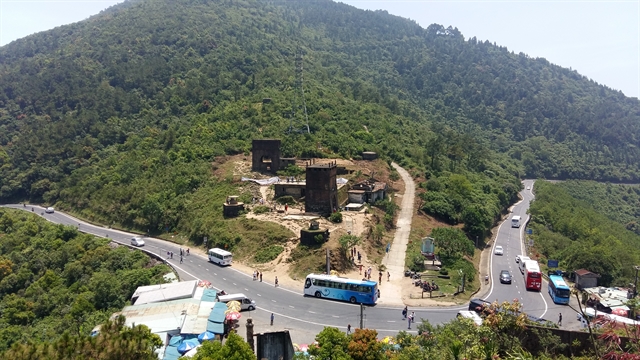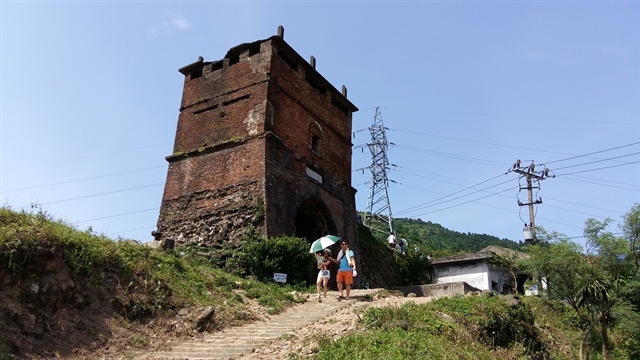
An aerial view of the Hải Vân Gate relic on top of the Hải Vân pass between Thừa Thiên Huế and Đà Nẵng. The two localities began restoring the site to as it was in previous centuries. — VNS Photo Công Thành
ĐÀ NẴNG — Authorities of the central city and Thừa Thiên-Huế Province have jointly begun a restoration and preservation project on the Hải Vân Gate at the border of the two localities on the Hải Vân Pass.
The project will cover 6,500sq.m, with a total of VNĐ42 billion (US$1.8 million) investment, using State funds from the two localities.
Director of the Huế Monuments Conservation Centre, Hoàng Việt Trung said the project would remove the octagonal bunkers that were built in 1945-75 and redecorate the site as it was in the Nguyễn Dynasty, including the damaged stone, brick walls and gates.
He said many new constructions such as high voltage power poles and telephone signal broadcasting stations had been carried out at the relic site in the late 1980s.
Trung said the preservation would focus on restoring ancient unique architecture and the design of old relics including the old citadel, the two gates and centuries-old north-south route on the top of Hải Vân Pass between Huế and Đà Nẵng.

A south gate on the Hải Vân Gate relic complex has preserved its brick structure. It was restructured with a concrete roof as a military checkpoint during the American War. —VNS Photo Công Thành
In 2017, the Ministry of Culture, Sports and Tourism promoted the Hải Vân Gate – a complex of brick-built gates dating from the Trần Dynasty – as a National Historical Relic and Architecture site.
The site has been in poor condition for the last two decades.
An excavation on the Hải Vân Gate complex in 2018 unveiled a clear layout of the old foundations of citadel walls and a section of the north-south route dating back to 1470.
Archaeologists also found the base level foundations of two gates built in 1826 – at the north and south – which were either changed of structure or damaged during the American war (1946-1975).
The original boundary of the Hải Vân Gate relic was overlapped by rock walls and tunnels built by the French and the US soldiers during the French and the American wars.
The 500m above sea level relic, which is on the border of Lăng Cô Town in Thừa Thiên-Huế Province’s Phú Lộc District and Đà Nẵng’s Hòa Hiệp Bắc Ward in Liên Chiểu District, attracts about 1,000 visitors per day.
It is situated on the Hải Vân Pass, 28km away from Đà Nẵng and 80km far from Huế, with access only for tankers or road adventurers travelling between Đà Nẵng and Huế since the Hải Vân tunnel became operational in 2005.
Historically, Hải Vân Pass belonged to the Hindu Champa Kingdom under Jaya Simhavarman III (1288-1307), but the two provinces of Ô (now Quảng Trị) and Lý (now Thừa Thiên-Huế) were given in exchange for the marriage of Huyền Trân Princess, daughter of King Trần Anh Tông. Hải Vân Pass then became the border between the Đại Việt and the Champa Kingdoms.
The two brick gates were reinforced with concrete and steel-bar roofs in the fight against Vietnamese guerillas (French colonial period) in 1826, and then during the American War.
In 1470, King Trần Nhân Tông named the Hải Vân Gate ‘the most marvellous wonder’. The inscriptions on the gate arches have survived. — VNS
OVietnam